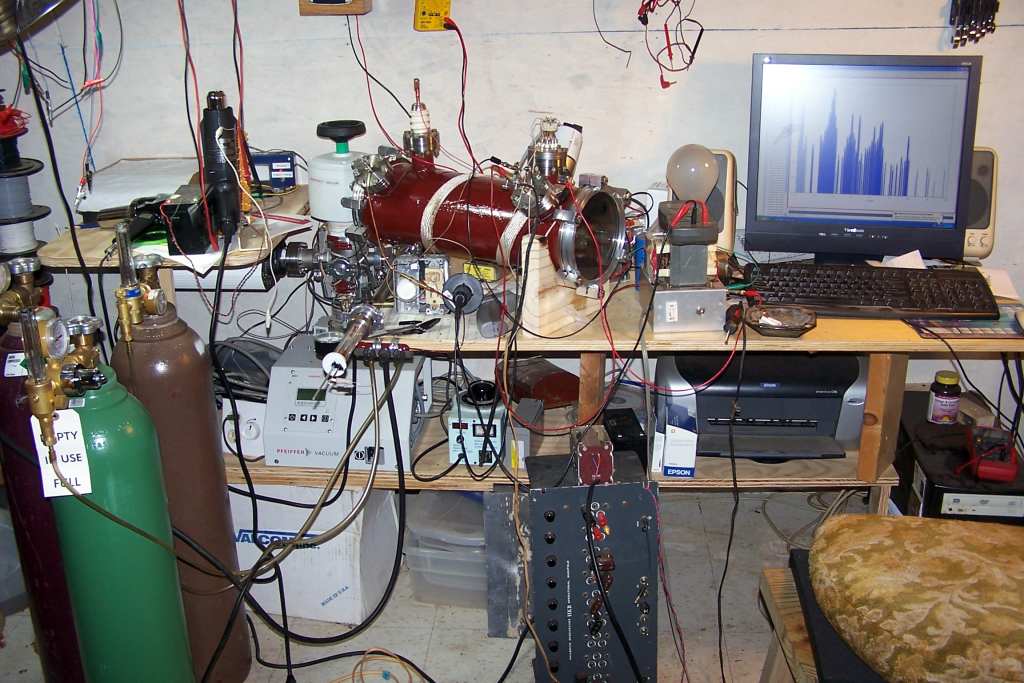 Here is my first really good vacuum system. In it we got into the plasma club, and I did a bunch of basic experiments on how to get good vacuum and maintain it, found out a bunch of gotchas, as might be expected, and did some work with glow discharge kinds of things. The system is a Pfeiffer turbo pumping station, 65 liters/second, with a mass spectrometer and a side tube on it with a tubing coupler for making glass glow tubes and sealing them off. I was also learning to do real TIG welding with this one, which is why the main tank is now painted with Glyptal to fix some leaks. Once I got started with that, well, seemed nice to finish the whole thing, though I've since learned to weld leak free. The base pressure on this system limits at about e-8 mbar on a good day after a back, due to all the tons of Viton seals in the system. More than good enough for fusion, and to be honest, the e-6 mbar it gets to quick is also just fine. The gas tanks are Ne (yeah!) He, and Ar for various tests. Of course I can use the latter two in my welding, but the Ne was kind of pricey for that. I now have a lifetime supply for many neon sign shops (or HeNe lasers), oh, how will I get by? This tank is now used as a pump station for transferring gases from tank to tank after pumping down the plumbing and the recipient tank, and quick-try experiments. Soon it will be further simplified to take on the road to do portable demos. I should say that though we have more and fancier gear, this is already better than needed for any fusion scenario we've run into or even imagined, and Pfeiffer gave me a pretty good deal and great support on this. The RGA shown here has since been upgraded by them at a discount to a full mass spectrometer, and now lives on the large system. If you look at the plot, you can see the water all the way from here -- water is the enemy to anything like a good vacuum, always, and especially in any system with any Viton in it -- and this one is all Viton sealed except for the welded in CF flanges you can see on the long main tank. Pretty good training wheels! Before this I had worked with one and two stage mechanical pumps, modified reefer compressors and so on. They don't cut it, but this is way better than needed. That other stuff is now relegated to a small demo bell jar system for doing things that don't require good clean vacuum, which actually is a lot of things, like evaporation, sputtering, making buckyballs and CVD kinds of stuff.
Here is my first really good vacuum system. In it we got into the plasma club, and I did a bunch of basic experiments on how to get good vacuum and maintain it, found out a bunch of gotchas, as might be expected, and did some work with glow discharge kinds of things. The system is a Pfeiffer turbo pumping station, 65 liters/second, with a mass spectrometer and a side tube on it with a tubing coupler for making glass glow tubes and sealing them off. I was also learning to do real TIG welding with this one, which is why the main tank is now painted with Glyptal to fix some leaks. Once I got started with that, well, seemed nice to finish the whole thing, though I've since learned to weld leak free. The base pressure on this system limits at about e-8 mbar on a good day after a back, due to all the tons of Viton seals in the system. More than good enough for fusion, and to be honest, the e-6 mbar it gets to quick is also just fine. The gas tanks are Ne (yeah!) He, and Ar for various tests. Of course I can use the latter two in my welding, but the Ne was kind of pricey for that. I now have a lifetime supply for many neon sign shops (or HeNe lasers), oh, how will I get by? This tank is now used as a pump station for transferring gases from tank to tank after pumping down the plumbing and the recipient tank, and quick-try experiments. Soon it will be further simplified to take on the road to do portable demos. I should say that though we have more and fancier gear, this is already better than needed for any fusion scenario we've run into or even imagined, and Pfeiffer gave me a pretty good deal and great support on this. The RGA shown here has since been upgraded by them at a discount to a full mass spectrometer, and now lives on the large system. If you look at the plot, you can see the water all the way from here -- water is the enemy to anything like a good vacuum, always, and especially in any system with any Viton in it -- and this one is all Viton sealed except for the welded in CF flanges you can see on the long main tank. Pretty good training wheels! Before this I had worked with one and two stage mechanical pumps, modified reefer compressors and so on. They don't cut it, but this is way better than needed. That other stuff is now relegated to a small demo bell jar system for doing things that don't require good clean vacuum, which actually is a lot of things, like evaporation, sputtering, making buckyballs and CVD kinds of stuff.The funny looking rack panel laying sideways on the floor is a Philbrick Op Amp manifold for those of you who are too young to remember the early days of tube type analog computers. This stuff is still useful today. For one thing, it's very hard to fry with extreme EMI events, and for another, it has 100 volt output levels easily. Just right for a lot of things if you can tolerate some drift and noise. In the picture, I had it lashed as a sawtooth generator to test an analog bargraph tube I built which is end on in the picture. On the desk is a small HV DC supply I made using microwave oven parts, with a huge bulb as a ballast to limit currents. This has been handy to make current limited glow discharges and such during pumpdowns, which is a faster way to bake than baking is.

This is the setup that got us into the forum's "plasma club". Pretty, but not very useful, and all the aspect ratios and speeds and feeds are wrong for fusion, but -- hey, it's purty. As you can see, I hadn't learned how to weld very well when I made this tank. Now it's not hard to get it essentially perfect on every try, but there is that period where one learns. The think sticking down from the top is a metal electron tube I cut off to play with electrons and beams of them. Turns out you can re-activate the old Ba/Sr/Ca cathodes a time or few after air exposure, but we've learned to use Y2O3; for that now, not as good the first time, but it lives through many air exposures. The stuff coming in from upper left is an adapter for a bakeout quartz halogen lamp I was experimenting with. Done right, this is faster and more power efficient than baking from outside, but as I mentioned above, not as good as simply running a hot glow discharge and re pumping a time or two. The messy weld on the upper right is the port for the Pfeiffer PKR-251 combined pirani/inverted magnetron ion gage. This has a heck of an external H field, and after watching it suck up ion beams and bend electron beams a bit (not seen in this photo) I fixed that by putting it on a long extension arm. The gas mix here is a purely arbitrary mix of the three gasses mentioned, just for good looks. It was encouraging to have the appearance of containing a plasma with a mere (small) electric field and nothing fancy. This was not the case of course, the eyes easily deceive one on this. The light only comes from electrons falling back into low energy states -- the actual plasma is anything but contained in this picture, just the place where the loss mostly occurs is "contained". But it was exciting and enough to keep me going. After all, this had cost me nearly the price of a new car -- cash-- at a time I wasn't well employed (C-Lab was in the process of retiring), and needed to feel I hadn't done something awfully stupid, just then. Gotta start someplace.
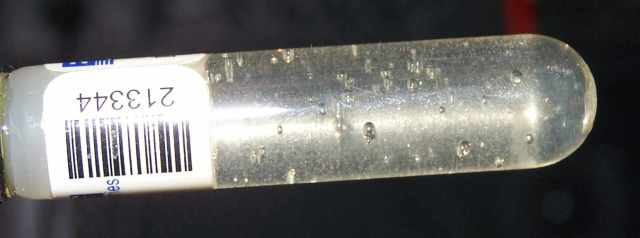 Around this time, I started looking for a way to detect neutrons, and a source of Deuterium with which to make them. I met Bill Fain on the fusor forum, and he is now my partner in this particular crime. If there is a better scrounger on this planet, I'd have trouble believing it. If you are desperate, we'll rent him out at say $100/hour, and he's worth it, like a winning lawyer or a good accountant. He of course found both things, quickly and cheaply, and the rest, as they say, is history. Bill decided he wanted in on this game, but lacks the tools and space to do it just now, so we built him a system too, which currently lives here (maybe we can finally talk his wife into letting him take it home, but it is useful where it is to test on diffusion pumped systems. This is a picture of a BTI bubble dosimeter with some bubbles in it indicating it has seen some neutrons. Now, as I pointed out at a recent HEAS meeting of other fusion aficionados, this is all about honesty -- these neutrons weren't from fusion at all. They were from a home made neutron source Bill found the parts for, a staticmaster brush 210Po source and some Be foil on top of that. But we don't cheat here, so I'm telling you like it is/was.
Around this time, I started looking for a way to detect neutrons, and a source of Deuterium with which to make them. I met Bill Fain on the fusor forum, and he is now my partner in this particular crime. If there is a better scrounger on this planet, I'd have trouble believing it. If you are desperate, we'll rent him out at say $100/hour, and he's worth it, like a winning lawyer or a good accountant. He of course found both things, quickly and cheaply, and the rest, as they say, is history. Bill decided he wanted in on this game, but lacks the tools and space to do it just now, so we built him a system too, which currently lives here (maybe we can finally talk his wife into letting him take it home, but it is useful where it is to test on diffusion pumped systems. This is a picture of a BTI bubble dosimeter with some bubbles in it indicating it has seen some neutrons. Now, as I pointed out at a recent HEAS meeting of other fusion aficionados, this is all about honesty -- these neutrons weren't from fusion at all. They were from a home made neutron source Bill found the parts for, a staticmaster brush 210Po source and some Be foil on top of that. But we don't cheat here, so I'm telling you like it is/was.
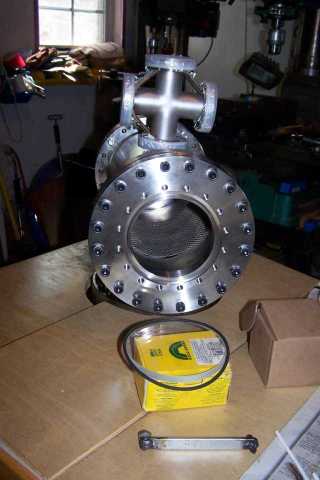 So, here is a picture of Bill's system being built. We made the nice table, the top of which we rarely see now as is the norm I suppose in any shop with never enough space. We were discussing whether to cut the bottom flange off the cross and weld the rest in, which we wound up doing as a quick way to get a lot of ports with little welding. It works great. We have since added more ports. You can see here that we put a SS mesh screen to keep the cylindrical field, well, cylindrical. We made some of the table top removable so as to make it easier to work on the other parts of the plumbing. Bill had found a big CF adapter flange, which we cut an O ring groove into to make it into a removable window, shown here. This works great and makes it very easy to get into the tank to fiddle with things. We did a similar mod on the back, using a Viton O ring and skipping most of the bolts there so that end comes off easily too. This work is already enough like trying to build a ship inside a bottle without making it extra hard. The high voltage input is in the back of the tank to keep it far from human contact in its intended destination where the table will be against a wall.
So, here is a picture of Bill's system being built. We made the nice table, the top of which we rarely see now as is the norm I suppose in any shop with never enough space. We were discussing whether to cut the bottom flange off the cross and weld the rest in, which we wound up doing as a quick way to get a lot of ports with little welding. It works great. We have since added more ports. You can see here that we put a SS mesh screen to keep the cylindrical field, well, cylindrical. We made some of the table top removable so as to make it easier to work on the other parts of the plumbing. Bill had found a big CF adapter flange, which we cut an O ring groove into to make it into a removable window, shown here. This works great and makes it very easy to get into the tank to fiddle with things. We did a similar mod on the back, using a Viton O ring and skipping most of the bolts there so that end comes off easily too. This work is already enough like trying to build a ship inside a bottle without making it extra hard. The high voltage input is in the back of the tank to keep it far from human contact in its intended destination where the table will be against a wall.
 Here is the underside plumbing. This is much more pump than is needed, but getting small stuff surplus is difficult. We have since found (I should say, Bill found) some smaller, newer pumping gear and intend to replace this with it to save on power and noise. Too much pump just means more troubles throttling it all to avoid having to push too much expensive Deuterium through there. The new stuff will be slower pumping, but much better ultimate vacuum than this. This setup runs fine though, with all cheapo Diffoil-20 from Lesker, the only problem if you call it that, is that it is just too good for this job, and a gate valve is hard to use as a conductance valve. We used a lamp dimmer to limit the power into the diffusion pump to help with that, but this is a very slow responding control, and fairly touchy itself. So, note to any beginners -- don't get pump envy or tank envy, you'll only make it harder, this system is what we made our first neutrons with and it was more than good enough. The rest of the table is set up as standard relay rack spacing to hold rack mount gear needed to run fusors. Not shown here is our dodge to run a diffusion pump in a room with no plumbing. We use a 5 gallon bucket and a fountain pump Bill found (those two words occur together quite a lot around here ;~) for the cooling water. It works, but for a long run we have to toss in some of that blue ice stuff they sell for campers to keep the water cool. At least it is self contained, and the dodge works, better now that we cut down the power to the diffusion pump to about half. We added a bit of insulation to the boiler so it could reach operating temperature at the lower power. The new stuff Bill found is all air cooled, which will indeed be a blessing. Not to mention save some hundreds of watts of vacuum system power consumption.
Here is the underside plumbing. This is much more pump than is needed, but getting small stuff surplus is difficult. We have since found (I should say, Bill found) some smaller, newer pumping gear and intend to replace this with it to save on power and noise. Too much pump just means more troubles throttling it all to avoid having to push too much expensive Deuterium through there. The new stuff will be slower pumping, but much better ultimate vacuum than this. This setup runs fine though, with all cheapo Diffoil-20 from Lesker, the only problem if you call it that, is that it is just too good for this job, and a gate valve is hard to use as a conductance valve. We used a lamp dimmer to limit the power into the diffusion pump to help with that, but this is a very slow responding control, and fairly touchy itself. So, note to any beginners -- don't get pump envy or tank envy, you'll only make it harder, this system is what we made our first neutrons with and it was more than good enough. The rest of the table is set up as standard relay rack spacing to hold rack mount gear needed to run fusors. Not shown here is our dodge to run a diffusion pump in a room with no plumbing. We use a 5 gallon bucket and a fountain pump Bill found (those two words occur together quite a lot around here ;~) for the cooling water. It works, but for a long run we have to toss in some of that blue ice stuff they sell for campers to keep the water cool. At least it is self contained, and the dodge works, better now that we cut down the power to the diffusion pump to about half. We added a bit of insulation to the boiler so it could reach operating temperature at the lower power. The new stuff Bill found is all air cooled, which will indeed be a blessing. Not to mention save some hundreds of watts of vacuum system power consumption.
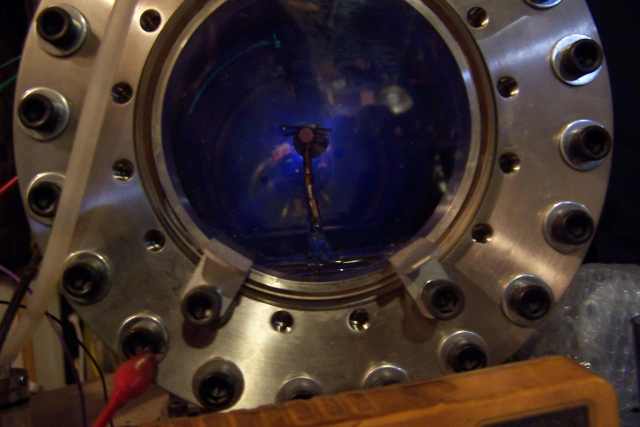 But of course this is what you came to see. This is or nearly is, the very first run in which we made a decent number of neutrons from fusion. We used electrolysis of heavy water (Bill found, need a macro to insert this wording!) for our fuel, which does work, though the results aren't pure, and an old X ray power supply, found by you know who, for HV power. Those were the (Bad) old days indeed. Everything was very cranky, it was like flying a helicopter upside down, blindfolded in high turbulence with one hand, and being a cat in a room full of rocking chairs. Everything was flakey, the HV supply was downright dangerous and very inefficient, the gas handling was poor, the grid got crooked in there, you name it. We overcame anyway. Hah! This system is in the process of being re commissioned, so expect more pictures and detail about it in a later report. Although neither as complex or as large as our main tank (which Bill found....) this is a Cadillac system itself, gives nothing up to the other one for practical use. The big turbo is a little easier to take up to atmosphere and get pumped back down quick but is harder to work inside of. Any engineer knows the words trade off.
But of course this is what you came to see. This is or nearly is, the very first run in which we made a decent number of neutrons from fusion. We used electrolysis of heavy water (Bill found, need a macro to insert this wording!) for our fuel, which does work, though the results aren't pure, and an old X ray power supply, found by you know who, for HV power. Those were the (Bad) old days indeed. Everything was very cranky, it was like flying a helicopter upside down, blindfolded in high turbulence with one hand, and being a cat in a room full of rocking chairs. Everything was flakey, the HV supply was downright dangerous and very inefficient, the gas handling was poor, the grid got crooked in there, you name it. We overcame anyway. Hah! This system is in the process of being re commissioned, so expect more pictures and detail about it in a later report. Although neither as complex or as large as our main tank (which Bill found....) this is a Cadillac system itself, gives nothing up to the other one for practical use. The big turbo is a little easier to take up to atmosphere and get pumped back down quick but is harder to work inside of. Any engineer knows the words trade off.
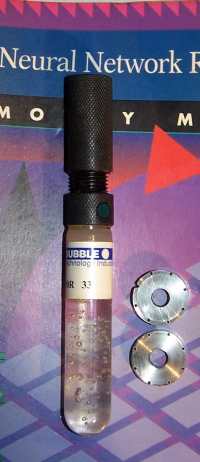 And, that run was a success, really nice all things considered. Perhaps only a mother could love it, but this was after a mere couple of years work, and it made us very happy. Here's a picture of the dosimeter from that run, during which we were only stable for a few seconds per few minutes, and the endcaps of the grid we built later for this tank. These are titanium, a nice material for this kind of work. It doesn't sputter much, it can take high temperatures, and it absorbs hydrogen (any isotope) for later release in pure form.
At the time (and still) we used various drilled endcaps with Ti wires through them, spot welded, to make grids, all the materials I found (for a change) at McMaster-Carr, a very handy vendor indeed.
And, that run was a success, really nice all things considered. Perhaps only a mother could love it, but this was after a mere couple of years work, and it made us very happy. Here's a picture of the dosimeter from that run, during which we were only stable for a few seconds per few minutes, and the endcaps of the grid we built later for this tank. These are titanium, a nice material for this kind of work. It doesn't sputter much, it can take high temperatures, and it absorbs hydrogen (any isotope) for later release in pure form.
At the time (and still) we used various drilled endcaps with Ti wires through them, spot welded, to make grids, all the materials I found (for a change) at McMaster-Carr, a very handy vendor indeed.
 During a somewhat later run, we discovered something by paying attention better than I think most would do. We were also using a REM-Ball detector for realtime neutron detection. During this run, we noticed that there was a heck of a lot of electrical noise, the cause of which was a ballast resistor opening up and arcing internally. We also noticed that the remball was only counting on noise pulses. There were noise pulses without counts, but no counts without pulses. This was my personal "Fleming moment" -- finding something very cool in what was otherwise a failed experiment and a pain of lost expensive components. I will discuss the theory later on in these threads, but it turns out there is a huge value to pulse mode over steady state, and instead of whining we'd burned out yet more parts, we looked on the bright side and it has paid off in way better modes of operation for fusors, especially with done on purpose rather than by accident.
As you might guess, I am fairly reluctant to even publish this picture, because I already know what will (and has already) happen. I will get all these comments about the EMI being the only thing there -- neutron counters are notorious for picking up noises and false counting, particularly this kind. In this shot, the upper trace is the LSB of a digital counter, plus noise, and the lower trace is the output of a NaI:Tl phototube head, buried in the same noise. To coin a phrase there's this "inconvenient truth" -- the bubbles in the BTI, which proves that there were indeed copious fusion reactions going on at the same time. This might be why scientists are not publishing much of their raw data, a shame in my eyes, because those who don't want to believe, and who don't actually have a clue, jump down your throat poo pooing what you know was real. We've since proven this time after time, so come on and whine if it makes you feel better to toss sour grapes. If you're nasty enough about it, I'll invite you here for a real big dose of high energy radiation or mail you something we made radioactive when things looked just like this. Hah! Just as not all things are as good as they look, neither are all things as bad as they seem, and frankly, this is proof that it pays to really pay attention and make very few assumptions. One assumption the nay-sayers incorrectly make is that I am NOT a 4 decade career engineer with plenty of experience pulling tiny signals out of huge noises for a living, a very good living indeed. Nuff said.
During a somewhat later run, we discovered something by paying attention better than I think most would do. We were also using a REM-Ball detector for realtime neutron detection. During this run, we noticed that there was a heck of a lot of electrical noise, the cause of which was a ballast resistor opening up and arcing internally. We also noticed that the remball was only counting on noise pulses. There were noise pulses without counts, but no counts without pulses. This was my personal "Fleming moment" -- finding something very cool in what was otherwise a failed experiment and a pain of lost expensive components. I will discuss the theory later on in these threads, but it turns out there is a huge value to pulse mode over steady state, and instead of whining we'd burned out yet more parts, we looked on the bright side and it has paid off in way better modes of operation for fusors, especially with done on purpose rather than by accident.
As you might guess, I am fairly reluctant to even publish this picture, because I already know what will (and has already) happen. I will get all these comments about the EMI being the only thing there -- neutron counters are notorious for picking up noises and false counting, particularly this kind. In this shot, the upper trace is the LSB of a digital counter, plus noise, and the lower trace is the output of a NaI:Tl phototube head, buried in the same noise. To coin a phrase there's this "inconvenient truth" -- the bubbles in the BTI, which proves that there were indeed copious fusion reactions going on at the same time. This might be why scientists are not publishing much of their raw data, a shame in my eyes, because those who don't want to believe, and who don't actually have a clue, jump down your throat poo pooing what you know was real. We've since proven this time after time, so come on and whine if it makes you feel better to toss sour grapes. If you're nasty enough about it, I'll invite you here for a real big dose of high energy radiation or mail you something we made radioactive when things looked just like this. Hah! Just as not all things are as good as they look, neither are all things as bad as they seem, and frankly, this is proof that it pays to really pay attention and make very few assumptions. One assumption the nay-sayers incorrectly make is that I am NOT a 4 decade career engineer with plenty of experience pulling tiny signals out of huge noises for a living, a very good living indeed. Nuff said.
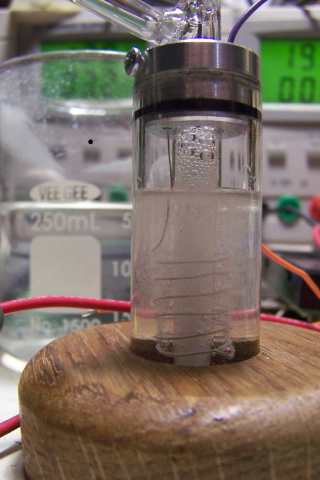 Here is the rig we used to get our deuterium at first, copied from some excellent work by Andrew Seltzman. Who, by the way I'd love to have walk in my door and want to work on this with us. The anode is platinum plated wire from SciToys, which works just as well as the far more expensive pure stuff we also tried. The center electrode, cathode, is a TIG welding rod, pure tungsten which seals fairly easily to the pyrex glass used here. Doug did the glass blowing, machining and woodwork on this and it does indeed make deuterium, along with allowing some dissolved air and normal hydrogen and plain old water through. Net D output is about 30% of what comes out, at best. I am tempted to try coating the water that is exposed to the air (so the O2 can get out) with oil, but we had enough accidents with this I decided against it. If you do this, never, ever walk away and leave it hooked to the tank. Although it gracefully handles making too much gas (the center tube fills up and strands the electrode, and it quits) the other case sucks heavy water and the NaCO3 into the tank, which of course clogs every orifice and valve with hard to remove solids, as well as losing your precious heavy water. Since we have since found that at least a small amount of contamination doesn't hurt fusion output, we may try this guy again someday, perhaps with our purifier on the south side of it. We'll have to see, that's low priority just now. This works fine running off a 5 volt DC supply, or you can use 12 volts if you want a lot of gas fast (and heat and water vapor).
Here is the rig we used to get our deuterium at first, copied from some excellent work by Andrew Seltzman. Who, by the way I'd love to have walk in my door and want to work on this with us. The anode is platinum plated wire from SciToys, which works just as well as the far more expensive pure stuff we also tried. The center electrode, cathode, is a TIG welding rod, pure tungsten which seals fairly easily to the pyrex glass used here. Doug did the glass blowing, machining and woodwork on this and it does indeed make deuterium, along with allowing some dissolved air and normal hydrogen and plain old water through. Net D output is about 30% of what comes out, at best. I am tempted to try coating the water that is exposed to the air (so the O2 can get out) with oil, but we had enough accidents with this I decided against it. If you do this, never, ever walk away and leave it hooked to the tank. Although it gracefully handles making too much gas (the center tube fills up and strands the electrode, and it quits) the other case sucks heavy water and the NaCO3 into the tank, which of course clogs every orifice and valve with hard to remove solids, as well as losing your precious heavy water. Since we have since found that at least a small amount of contamination doesn't hurt fusion output, we may try this guy again someday, perhaps with our purifier on the south side of it. We'll have to see, that's low priority just now. This works fine running off a 5 volt DC supply, or you can use 12 volts if you want a lot of gas fast (and heat and water vapor).